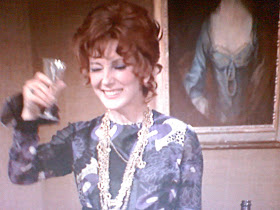Karen Black strikes the right tone in 1975's TV movie
Trilogy of Terror
, directed by campy, goth horror trailblazer Dan Curtis (
Dark Shadows
). "Amelia" is the best known of the three, based upon a Richard Matheson story "Prey" (originally published in
Playboy), the title character buys a Zuni fetish doll with hopes of impressing her anthropologist boyfriend. Soon enough she is viciously attacked by the unrelenting doll in her apartment in a gleefully wicked sequence. The ending is fun as well.

It's easy to see how "Amelia" was seared in childhood memories of anyone watching in '75. The other stories are much more mild, hokey affairs with predictable twists but worth a watch for Karen Black's impressive range: she plays a geeky, tightly-wound teacher in "Julie" and dueling twins in "Millicent and Therese." With her strange, compelling eyes, and ability to change the register in her voice on a whim, only Black seems suited for all these parts. She has said that the film's subsequent notoriety and cult status typecast-ed her for horror: "I think this little movie took my life and put it on a path that it didn't even belong in." **1/2
The directorial work of Curtis is much more hackneyed in his
1996 sequel
.
Lysette Anthony, not as beguiling as Karen Black, takes on three of the main roles. In "The Graveyard Rats," she plays a cold wife, who, along with her lover (
Geraint Wyn Davies), plots her husband's death. It's a slow build-up (with a references to noir like
Kiss of Death
) and it takes too long for the giant, animatronic rats to make their entrance.
For those looking for a good laugh, the last entry, a sub-par sequel to "Amelia," "He Who Kills" features the Zuni doll on-the-loose in a museum after-hours, assaulting a scientist (Anthony).
Curtis' '96 version of "Bobby" (also based upon a Matheson story) features a way too over-the-top Anthony mourning her dead son and bringing him back from the sea. The theatrics, ridiculous mansion setting, makes it feel soap opera glossy instead of scary. *1/2
A far better version of "Bobby" figures in Curtis' 1977 anthology
Dead of Night
(not to be confused with the brilliant 1945
film
with the same title).
Joan Hackett stars as the grieving mother, who uses black candles and a spell to bring her son (
Lee Montgomery) back. Her '70s split level is creepy enough, with its potted plants, orange shag carpets, and pea-green tinted lighting. With such an eerie atmosphere and complex menace (stalking about in his blue pajamas and bedroom slippers), it might be my favorite Curtis film of the pack and it's pretty stunning, especially in comparison to his '96 rehash.
The other two films in
Dead of Night
aren't as frightening. There's a predictable, pre-
Back to the Future ,
, pre-
Midnight in Paris
ditty about a 1920s car that transports
Ed Begley, Jr. back in time and a plodding vampire tale, so over-the-top with its goth, I quickly lost interest. Overall it's worth a look... but mostly for "Bobby." **1/2
Other reviews of these films by Dan Curtis:
The Bloody Pit of Horror





















